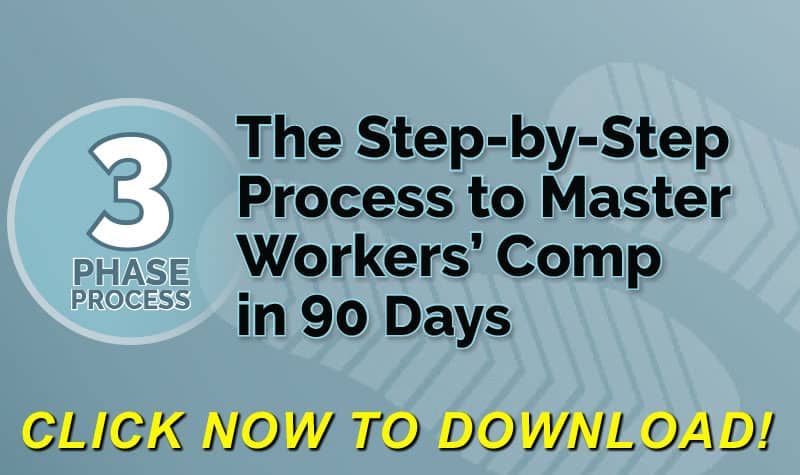Determining lag time is one of the easiest things to measure in workers’ compensation. Yet many organizations put little if any effort into it. More than likely they don’t see the value in tracking that particular metric.
But those that do report better outcomes for their injured workers and significant dollars saved for their bottom lines. There’s substantial research to back them up.
Why Workers’ Comp Claim Lag Time Matters
Lag time refers to the time period from the moment of injury until it is reported to the insurance carrier. For example, if an injury occurs on Oct. 1 and the insurer receives notice of the claim on Oct. 3, the claim will have a report lag of two days.
Tracking a company’s lag time is fairly simple, since every claims handler or adjuster has the information. The goal is to have shorter lag time, as several studies reveal tremendous cost differences.
Click Link to Access Free PDF Download
Kemper Insurance Study
Kemper Insurance did a study and found that a claim reported within 30 days is 48 percent higher on average than a claim reported within 10 days of an injury.
The Hartford Insurance Study
The Hartford looked at 53,000 permanent partial and temporary claims and found the cost of a claim increases with each passing week before the incident is reported. Compared to an injury reported within week:
- Within 2 weeks the claim was 18 percent more expensive
- Within 3 weeks the claim cost 29 percent more
- Within 4 weeks there was a 31 percent cost difference
- Within 5 weeks, the claim was on average 45 percent more expensive
NCCI Study
NCCI’s study found “the closure ratio — the ratio of the number of claims closed within 18 months of the report date to the total number of claims — is inversely related to the median claim cost … the highest closure ratios are for claims reported in Weeks 1 and 2. Claims reported after Week 2 are less likely to be closed at 18 months…”
The study also found that median claims costs were lowest for claims reported after the day of the accident but within two weeks. It noted that claims reported on the actual day of the accident can be costly, as these are often the most serious injuries and require emergency care.
Additionally, longer lag times were associated with:
- Greater attorney involvement —12.8 percent after more than 1 week, increasing to 148 percent more than 5 weeks after injury.
- More use of lump-sum payments
- Lower paid-to-incurred ratio at 18 months
- Lower closure rate at 18 months.
The data indicates that claims with a lag time of more than two weeks are more complex, take longer to close, and have longer disability durations.
Why Workers’ Comp Claim Lag Time Is Important
There are many possible reasons that increased lag times result in increased costs. Experts speculate some include:
- An injured worker may visit a primary care physician rather than an occupational physician who understands return-to-work and other elements of the workers’ compensation system.
- The worker may feel he and his injury are being ignored, that the company doesn’t care about him. That could drive him to seek an attorney.
- Quicker reporting means faster medical treatment which results in faster RTW rates.
Tracking lag time helps you and others at your organization better understand how well your program is working. You can use it, along with the available research to show the cost savings you are achieving by having shorter lag times.
Organizations with multiple divisions can compare the lag times for each to show which are doing a better job of getting injuries reported quicker.
Improving Workers’ Comp Claim Lag Time
Getting injuries reported to the carrier as quickly as possible takes a concerted effort and should be embraced by everyone in the organization. The employee needs to report the injury immediately and the supervisor must complete the necessary paperwork to get the report to the carrier as soon as possible. Senior managers should consider the issue a priority as well.
Getting the buy-in of all involved takes some education, so everyone understands the value in shorter lag times and the process required. Injured workers should be made aware that reporting an injury sooner means they will get the medical attention and care they need immediately. Supervisors and managers need also to understand the financial impact of shorter lag times.
FREE DOWNLOAD: “Step-By-Step Process To Master Workers’ Comp In 90 Days”
There are several ways to ensure better lag times:
- An employee brochure. This should explain the workers’ compensation process and be provided to all personnel.
- One-pager. A short notice that explains the process for reporting an injury should be available to all employees. It can be posted in areas where workers congregate, placed in company vehicles, and even provided on the back of a lanyard.
- Employee training and retraining. In addition to providing written material, new hires should undergo training on proper incident reporting. This should be repeated as retraining annually.
- Supervisor education. All supervisors and managers should be well versed on the process required once an employee reports an injury. This can even be part of their performance reviews.
- Make it easy. A complicated reporting process is more likely to incur longer lag times. There should be a single contact within the organization to report injuries when a supervisor or manager is unavailable, such as a single phone number.
Summary
Improving and tracking lag time are fairly simple processes and can have a tremendous impact on the company’s bottom line. The sooner an injury is reported, the sooner the worker will receive medical care and return to work, and the better off the organization will be.

Author Michael Stack, CEO Amaxx LLC. He is an expert in workers’ compensation cost containment systems and helps employers reduce their workers’ comp costs by 20% to 50%. He works as a consultant to large and mid-market clients, is a co-author of Your Ultimate Guide To Mastering Workers Comp Costs, a comprehensive step-by-step manual of cost containment strategies based on hands-on field experience, and is founder & lead trainer of Amaxx Workers’ Comp Training Center .
Contact: mstack@reduceyourworkerscomp.com.
Workers’ Comp Roundup Blog: https://blog.reduceyourworkerscomp.com/
©2018 Amaxx LLC. All rights reserved under International Copyright Law.
Do not use this information without independent verification. All state laws vary. You should consult with your insurance broker, attorney, or qualified professional.
FREE DOWNLOAD: “Step-By-Step Process To Master Workers’ Comp In 90 Days”




